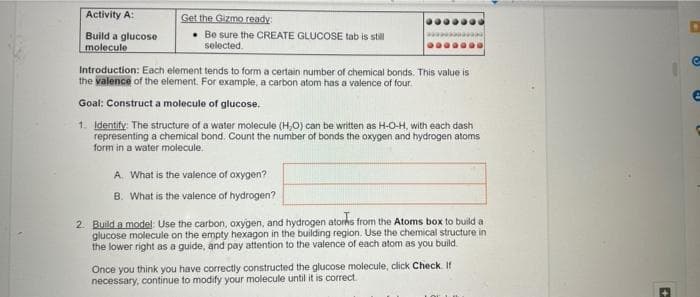Activity A: Get the Gizmo ready: Build a glucose molecule • Be sure the CREATE GLUCOSE tab is stil selected. Introduction: Each element tends to form a certain number of chemical bonds. This value is the valence of the element. For example, a carbon atom has a valence of four. Goal: Construct a molecule of glucose. 1. Identity: The structure of a water molecule (H,O) can be written as H-O-H, with each dash representing a chemical bond. Count the number of bonds the oxygen and hydrogen atoms form in a water molecule. A. What is the valence of oxygen? B. What is the valence of hydrogen? 2. Build a model Use the carbon, oxygen, and hydrogen atorhs from the Atoms box to build a glucose molecule on the empty hexagon in the building region. Use the chemical structure in the lower right as a guide, and pay attention to the valence of each atom as you build. Once you think you have correctly constructed the glucose molecule, click Check If necessary, continue to modify your molecule until it is correct.
Formal Charges
Formal charges have an important role in organic chemistry since this concept helps us to know whether an atom in a molecule is neutral/bears a positive or negative charge. Even if some molecules are neutral, the atoms within that molecule need not be neutral atoms.
Polarity Of Water
In simple chemical terms, polarity refers to the separation of charges in a chemical species leading into formation of two polar ends which are positively charged end and negatively charged end. Polarity in any molecule occurs due to the differences in the electronegativities of the bonded atoms. Water, as we all know has two hydrogen atoms bonded to an oxygen atom. As oxygen is more electronegative than hydrogen thus, there exists polarity in the bonds which is why water is known as a polar solvent.
Valence Bond Theory Vbt
Valence bond theory (VBT) in simple terms explains how individual atomic orbitals with an unpaired electron each, come close to each other and overlap to form a molecular orbital giving a covalent bond. It gives a quantum mechanical approach to the formation of covalent bonds with the help of wavefunctions using attractive and repulsive energies when two atoms are brought from infinity to their internuclear distance.

Trending now
This is a popular solution!
Step by step
Solved in 3 steps with 1 images









